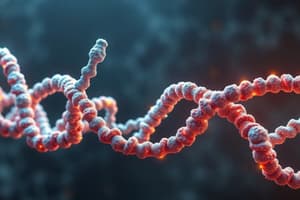Podcast
Questions and Answers
Which of the following is the correct single letter code translation for the amino acid sequence 'Met-Ala-Ala-Glu-Cys-His-Gly'?
Which of the following is the correct single letter code translation for the amino acid sequence 'Met-Ala-Ala-Glu-Cys-His-Gly'?
- MAECG
- MAAECHG
- MAAEGCH
- MAAECG (correct)
What is the main driving force in protein folding?
What is the main driving force in protein folding?
- To hide hydrophobic side chains from water molecules
- To form a hydrophobic core
- To neutralize polar C=O and N-H groups
- To attain an energetically stable structure (correct)
Which of the following is NOT an important type of secondary structure in proteins?
Which of the following is NOT an important type of secondary structure in proteins?
- Alpha helix
- Beta sheet
- Gamma helix (correct)
- Random coil
How many amino acids are usually present in an alpha helix?
How many amino acids are usually present in an alpha helix?
What is the pitch (turn length) of an alpha helix?
What is the pitch (turn length) of an alpha helix?
What are the main chain groups in an alpha helix that are hydrogen bonded to one another?
What are the main chain groups in an alpha helix that are hydrogen bonded to one another?
What is the vertical distance between two amino acids in an alpha helix?
What is the vertical distance between two amino acids in an alpha helix?
Which of the following is true about the alpha helix?
Which of the following is true about the alpha helix?
Which of the following describes the beta sheet?
Which of the following describes the beta sheet?
What is the term for the regions that connect anti-parallel beta strands?
What is the term for the regions that connect anti-parallel beta strands?
Which amino acid is often found in loop regions because its locked ring structure introduces a 'kink' into the polypeptide chain?
Which amino acid is often found in loop regions because its locked ring structure introduces a 'kink' into the polypeptide chain?
What is the term for the final three-dimensional structure of a protein?
What is the term for the final three-dimensional structure of a protein?
What are proteins always synthesized using?
What are proteins always synthesized using?
What are the modifications to proteins after synthesis called?
What are the modifications to proteins after synthesis called?
How do parallel beta strands connect?
How do parallel beta strands connect?
The C=O group of amino acid n is hydrogen bonded to the N-H group of amino acid n+4.
The C=O group of amino acid n is hydrogen bonded to the N-H group of amino acid n+4.
The α helix is formed from continuous regions of the polypeptide chain.
The α helix is formed from continuous regions of the polypeptide chain.
The β sheet is formed from non-continuous regions of the polypeptide chain.
The β sheet is formed from non-continuous regions of the polypeptide chain.
Loop regions in proteins are always highly flexible.
Loop regions in proteins are always highly flexible.
Proteins can be modified after synthesis in various ways, including the addition of sugars and lipids.
Proteins can be modified after synthesis in various ways, including the addition of sugars and lipids.
Flashcards are hidden until you start studying
Study Notes
Primary Structure
- The primary structure of a protein is the sequence of amino acids from N-terminal to C-terminal.
- This sequence can be written out using standard abbreviations for amino acids or a single letter code.
- Example: Ile-Ala-Met-Ala-Pro-Glu-Pro-Thr-Ile-Asp-Glu can be translated into single letter code.
Secondary Structure
- The secondary structure of a protein is the folding of parts of the primary sequence into specific structures.
- Two important types of secondary structure are the alpha (α) helix and the beta (β) sheet.
Alpha Helix
- The α helix is usually formed from stretches of 5-40 amino acids.
- The main chain N-H and C=O groups are hydrogen bonded to one another along the axis of the helix.
- The α helix is very stable.
- There are 3.6 amino acids per turn.
- Each amino acid turns the helix through 100°.
- The vertical distance from one amino acid to the next is 0.15nm, so the pitch of the helix (turn length) is 0.54nm.
- The C=O group of amino acid n is hydrogen bonded to the N-H group of amino acid n+4.
- The amino acid side chains project out from the edge of the helix.
- The sequence of amino acids in an α helix can be plotted on a helical wheel diagram.
Beta Sheet
- The β sheet is formed from non-continuous regions of the polypeptide chain, called β strands.
- The β strands line up and form hydrogen bonds between the C=O groups of one strand and the N-H groups of another.
- If the strands all run in the same direction (N → C), the β sheet is described as PARALLEL.
- If the strands run in opposite directions, the β sheet is described as ANTI-PARALLEL.
- β sheets, including parallel and anti-parallel, are often called β-pleated sheets.
Loop Regions
- Loop regions link secondary structures (α helices, β sheets) together.
- Loops vary in length, with long loops called random coils and being highly flexible parts of proteins.
- Short loop regions that connect anti-parallel β strands are called hairpin loops or β turns.
- PROLINE is often found in loop regions because its locked ring structure introduces a ‘kink’ into the polypeptide chain.
- GLYCINE is also often found in loops because its small side chain enables it to form turns when other amino acids could not.
Post-translational Modifications
- Proteins are synthesised using the same set of 20 amino acids.
- However, they can be modified after synthesis in various ways.
- Alterations to some produce the “rare” amino acids – hydroxyproline, hydroxylysine.
- Sugars/carbohydrates/glycans can be added to some amino acids (asparagine, threonine, serine) – this is called glycosylation – glycoproteins (N-linked, O-linked).
- Lipids can also be added – lipoproteins.
- These post-translational modifications can contribute to secondary structure.
Tertiary Structure
- The final three-dimensional structure of a protein is produced by the association of secondary structures into compact domains.
- This is called TERTIARY STRUCTURE.
Studying That Suits You
Use AI to generate personalized quizzes and flashcards to suit your learning preferences.




